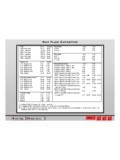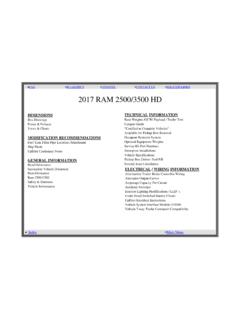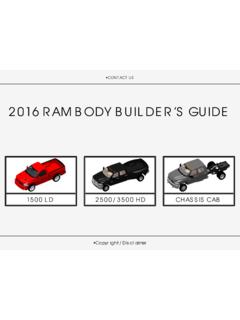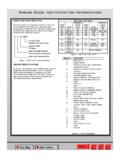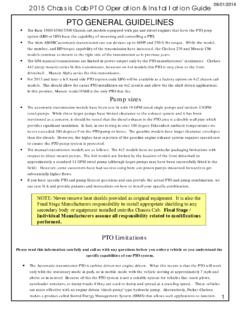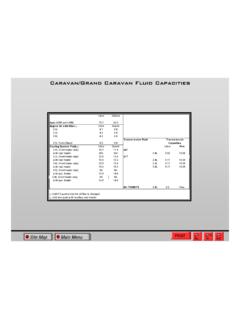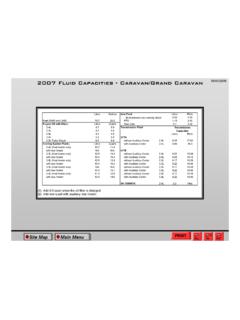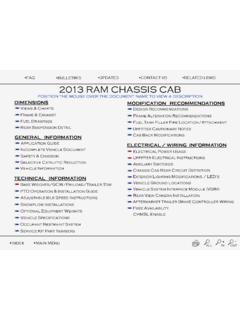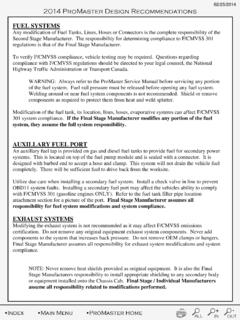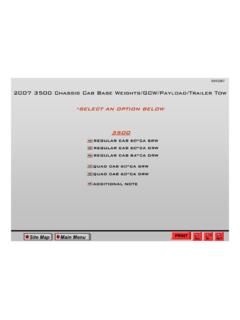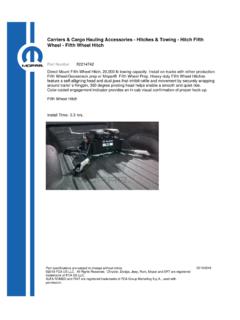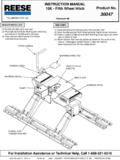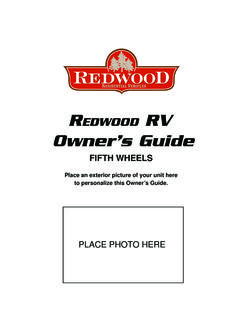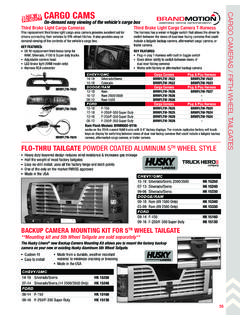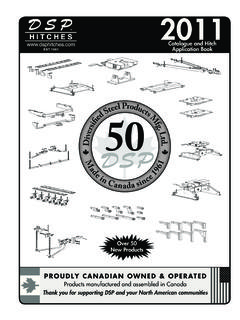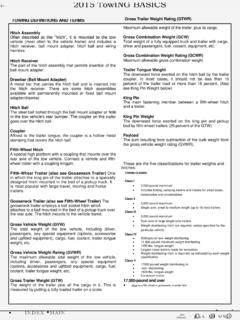Transcription of TOWING DEFINITIONS AND TERMS Gross Trailer …
1 Main MenuSite MapALLIN+OUT-PRINT2007 TOWING BasicsTOWING DEFINITIONS AND TERMS Hitch Assembly Often described as the hitch , it is mounted to the tow vehicle (most often to the vehicle frame) and includes a hitch receiver, ball mount adapter, hitch ball and wiring harness. Hitch Receiver The part of the hitch assembly that permits insertion of the ball mount adapter. Drawbar (Ball Mount Adapter) A metal bar that carries the hitch ball and is inserted into the hitch receiver. There are some hitch assemblies available with permanently mounted or fixed ball mount adapter/drawbar. Hitch Ball The steel ball bolted through the ball mount adapter or hole in the tow vehicle s rear bumper.
2 The coupler on the Trailer goes over the hitch ball. Coupler Affixed to the Trailer tongue, the coupler is a hollow metal stamping that covers the hitch ball. fifth - wheel Hitch A special high platform with a coupling that mounts over the rear axle of the tow vehicle. Connect a vehicle and fifth - wheel Trailer with a coupling kingpin. fifth - wheel Trailer (also see Gooseneck Trailer ) One in which the king pin of the Trailer attaches to a specially designed hitch mounted in the bed of a pickup truck. It is most popular with large travel, moving and horse trailers. Gooseneck Trailer (also see fifth - wheel Trailer ) The gooseneck Trailer employs a ball socket hitch which attaches to a ball mounted in the bed of a pickup truck over the rear axle.
3 The hitch mounts to the vehicle frame. Gross Vehicle Weight (GVW) The total weight of the tow vehicle, including driver, passengers, any special equipment (options, accessories and upfitted equipment), cargo, fuel, coolant, Trailer tongue weight, etc. Gross Vehicle Weight Rating (GVWR) The maximum allowable total weight of the tow vehicle, including driver, passengers, any special equipment (options, accessories and upfitted equipment), cargo, fuel, coolant, Trailer tongue weight, etc. Gross Trailer Weight (GTW) The weight of the Trailer plus all the cargo in it. This is measured by putting a fully loaded Trailer on a scale.
4 Gross Trailer Weight Rating (GTWR) Maximum allowable weight of the Trailer , plus its cargo. Gross Combination Weight (GCW) Total weight of a fully equipped truck and Trailer with cargo, driver and passengers, fuel, coolant, equipment, etc. Gross Combination Weight Rating (GCWR) Maximum allowable Gross combination weight. Trailer Tongue Weight The downward force exerted on the hitch ball by the Trailer coupler. In most cases, it should not be less than 10 percent of the Trailer load or more than 15 percent. (Also see King Pin Weight below) King Pin The main fastening member between a fifth - wheel hitch and a Trailer .
5 King Pin Weight The downward force exerted on the king pin and pickup bed by fifth - wheel trailers (25 percent of the GTW) Payload The sum resulting from subtraction of the curb weight from the Gross vehicle weight rating (GVWR). TOWING CLASSES These are the five classifications for Trailer weights and hitches: Class I Light Duty z 2,000-pound maximum z Includes folding camping trailers and trailers for small boats, motorcycles and snowmobiles Class II Medium Duty z 3,500-pound maximum z Single-axle, small to medium length (up to 18 feet) trailers Class III Heavy Duty z 5,000-pound maximum z Dual-axle or large single-axle trailers z Weight-distributing hitch not required, unless specified for the particular vehicle Class IV Extra Heavy Duty z 12,000-pound maximum z Largest travel trailers made for recreation z Weight-distributing hitch is required.
6 As indicated by each weight classification 12,000-pound and over z Must be a fifth - wheel or gooseneck, or pintle hitch 09/01/2006 Main MenuSite MapALLIN+OUT-PRINT2007 TOWING BasicsNOTES ON GETTING HITCHED Weight-Carrying Hitch A weight-carrying hitch supports the Trailer tongue weight, just as if it were luggage located at a hitch ball or some other connected point of the truck. These kinds of hitches are commonly used to tow small and medium sized trailers. There are three styles of weight-carrying hitches: z Fixed Drawbar in which the ball platform is permanently welded to the hitch z Removable Drawbar in which the ball platform is removable.
7 This hitch is commonly referred to as a utility ball mount for Class III hookups Fixed Drawbar Removable Drawbar Pintle Hitch Weight-Distributing Hitch A weight-distributing system includes a receiver attached to the tow vehicle, plus a removable hitch head and spring bar assembly that fits into the receiver opening and hook up brackets that connect the spring bars to the Trailer frame. This allows TOWING of trailers with greater tongue weights typically Class IV categories up to 12,000 pounds. Weight Distributing Hitch fifth - wheel HitchA fifth - wheel hitch is a special platform with a coupling that mounts over the rear axle of the tow vehicle.
8 It connects a vehicle and fifth - wheel Trailer with a coupling king pin. It is most popular with large travel, moving trailers. fifth - wheel Hitch TOWING AND AXLE RATIOS On rear- wheel -drive vehicles, rear-axle ratio is an important part of a successful TOWING equation. It is expressed as a ratio between the driveshaft revolutions per minute and the rear axle's revolutions per minute. It is always given as a numerical shaft expression like :1. This means the small pinion gear at the end of the drive shaft must rotate times for every single rotation of the rear axle / shafts.
9 Each rear-axle ratio in the spectrum of those offered has a plus and minus. A ratio that is "low" in the number of drive shaft rotations for every axle rotation results in lower engine rpm and in better fuel economy, longer engine life and quieter running. But it won't be good for quick acceleration, climbing grades, carrying loads or pulling a Trailer . A "high" ratio, one with a high number of drive shaft turns like the :1 example above, is better for quick acceleration, climbing grades, carrying loads or pulling a Trailer . However, it results in lower fuel economy and is noisier when running at high vehicle speeds.
10 For any application, it is best to determine a ratio that will enable your Dodge vehicle to pull a Trailer with the engine operating closest to its optimal power range - where peak torque and peak horsepower meet on the engine power curve chart. This maximizes power, efficiency fuel economy. It is best to determine a ratio that will give good Trailer TOWING power without handicapping non- TOWING performance too severely. 09/01/2006 Main MenuSite MapALLIN+OUT-PRINT2007 TOWING Basics09/01/2006 TOWING MATH The TOWING charts located in the Model Lineup section of each vehicle in the 2007 Body Builder s Guide shows z Model z Engine z Transmission z Axle ratio z GVWR z Payload z Front and rear curb weight z Front and rear GAWR z GCWR z Max allowable Trailer weight To use the TOWING charts, first calculate the GCW of the TOWING vehicle and GTW of Trailer to make sure that everything falls within the GCWR listed.
